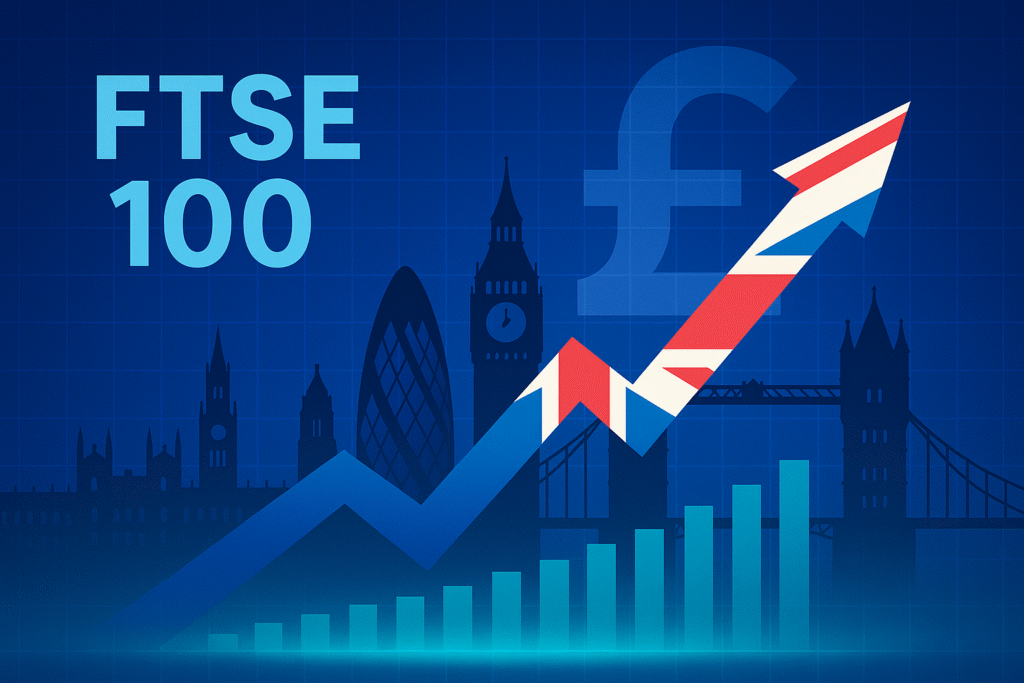FTSE 100, the flagship UK equity benchmark, represents the 100 largest companies listed on the London Stock Exchange by free-float market value, thereby offering a real-time barometer of Britain’s blue-chip corporate sector. Consequently, the FTSE 100 is a go-to gauge for income seekers, macro hedgers, and global allocators alike.

1. Snapshot (May 2025)
| Metric | Value | Transition Note |
|---|---|---|
| Index Level | 8 120 | To begin with, the index sits near record territory. |
| Market Cap | £1.9 trillion | Meanwhile, deep liquidity attracts foreign capital. |
| Dividend Yield | 3.8 % | Thus, payouts comfortably top global averages. |
| Launch Date | January 1984 | Accordingly, a long history aids cycle analysis. |
| Currency | Pound sterling | Therefore, FX swings directly affect returns. |
2. How the FTSE 100 Is Built
| Rule | Detail | Transition Note |
|---|---|---|
| Constituents | Top 100 free-float companies on LSE Main Market | First and foremost, size and liquidity drive selection. |
| Weighting | Free-float market-cap; 10 % cap at quarterly review | Consequently, single-stock risk is contained. |
| Review Schedule | First Wednesday of Mar, Jun, Sep, Dec | Moreover, timely rebalances keep the basket relevant. |
| Liquidity Screen | Minimum 0.05 % median daily trading volume | Hence, thinly traded names stay out. |
If a member falls below 111th place it exits; conversely, firms ranked 90th or better are promoted—thereby preserving the FTSE 100’s blue-chip status.
3. Sector Breakdown (April 2025)
| Sector | Weight | Transition Note |
|---|---|---|
| Financials | 20 % | Chiefly, banks and insurers dominate cash flows. |
| Energy | 15 % | Meanwhile, oil majors hedge inflation. |
| Consumer Staples | 14 % | Additionally, defensive brands steady volatility. |
| Health Care | 11 % | Likewise, pharma offers secular growth. |
| Industrials | 10 % | Thus, engineering ties to global CapEx. |
| Materials | 9 % | Furthermore, miners ride commodity cycles. |
| Others | 21 % | Collectively, telecoms, real estate, and utilities round exposure. |
Because global multinationals dominate revenues, the FTSE 100 earns roughly 75 % of sales outside the UK; accordingly, sterling weakness typically lifts index EPS.
4. Recent Performance
| Year | Total Return (GBP) | Key Drivers | Transition Note |
|---|---|---|---|
| 2022 | –0.3 % | Energy boom offset rate fears | Initially, commodity strength proved a cushion. |
| 2023 | +7.2 % | Oil strength, defensive staples | Subsequently, defensives underpinned gains. |
| 2024 | +5.8 % | Weak pound, mining rebound | Moreover, FX tailwinds helped exporters. |
| YTD 2025 | +3.6 % | Bank earnings beat, soft sterling | So far, financials propel returns. |
Volatility averages 15 %, therefore lower than Euro-Stoxx 50 thanks to the FTSE 100’s defensive tilt.
5. Why Investors Track the FTSE 100
- Income Play. A yield near 4 % consequently appeals to dividend hunters.
- Commodity & FX Hedge. Energy, miners, and USD-earners gain when sterling weakens; thus, the index acts as a macro hedge.
- Derivatives Liquidity. ICE FTSE futures and options trade over £3 billion notional daily, thereby enabling efficient hedging.
- ETF Access. Funds such as ISF (UK) and EWU (US) replicate the FTSE 100, hence providing low-cost exposure.
6. Strengths & Caveats
| Strengths | Caveats |
|---|---|
| High dividend stream, global revenue mix. | However, the domestic UK economy is under-represented. |
| Quarterly rebalancing keeps basket fresh. | 10 % cap still leaves top five stocks ≈ 35 % weight. |
| Deep derivatives market aids hedging. | Heavy energy/mining weight raises cyclicality. |
7. Themes to Watch
- Energy Transition. Renewables spin-offs could eventually shift sector weights, therefore altering FTSE 100 dynamics.
- UK M&A Wave. Weak sterling invites foreign bids, potentially shrinking free float.
- Tech Gap. London’s push for dual-class listings aims to attract growth IPOs, thus broadening sector exposure.
- Monetary Policy. BoE cuts forecast for Q4 2025 would boost domestically oriented plays such as utilities and real estate.
Key Takeaways
The FTSE 100 aggregates the UK’s largest free-float companies, yielding 3.8 % with broad global revenue exposure. Ultimately, investors use the FTSE 100 for dividend income, macro hedging, and benchmarking UK-listed blue-chips—yet they must remain mindful of its commodity bias and sensitivity to sterling moves.